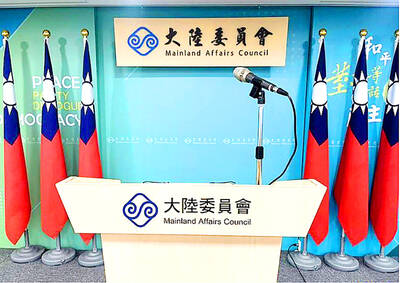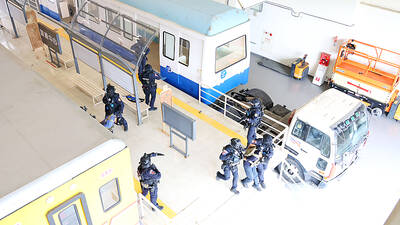Despite warming cross-strait ties, China has not relented on its military buildup and “may attempt a direct assault on Taiwan proper” when it has amassed enough amphibious transport vehicles or when the situation calls for it, according to this year’s Ministry of National Defense report on the military capability of the People’s Liberation Army (PLA).
The report, released on Friday, marked the first time that the ministry had mentioned the possibility of China making a direct assault on the nation in all the past estimates of PLA military capability.
According to the report’s analysis on the combat capability of the PLA and the threat it poses to Taiwan, the PLA as yet lacks sufficient amphibious transport boats in its regular army and does not have the capability to launch a general invasion of Taiwan.
Currently, China still relies on intimidation tactics, running blockades and the threat of artillery or missile bombardment as possible methods of answering hostile cross-strait situations, the report said.
However, the report said that with the continued upgrading of the PLA’s military equipment through arms purchases and research and development, the cross-strait military imbalance would only accelerate.
It added that the PLA’s growing investment in military equipment would also increase the difficulty of any foreign intervention in cross-strait affairs.
With China’s GDP growing nearly 10 percent from 1979 to 2008, and 9.2 percent just in the past year, the report says that China has become the second-largest economy in the world, providing a robust source of funding for national defense.
Since 1989, China’s national defense budget has been growing at a fixed two-digit figure every year and its national defense budge next year is to reach 670 billion yuan (US$105 billion), 67 billion yuan more than last year, equivalent to an increase of 11.2 percent, the report said.
Because China’s research and development, arms sales profits, arms purchases expenditure, national defense industry profits and its budget for the People’s Armed Police (PAP) are excluded from its national defense budget, it is estimated that the amount of unlisted military expenditure is between two and three times the published amount, the report said.
According to statistics in the report, the Chinese Military and its Second Artillery Corp — China’s strategic missile force — has 2.3 million soldiers and China is seeking to increase their mechanization and digitization.
China is also seeking to enhance coordination of its army and air force rapid assault capabilities and special forces combat capability, the report said, adding that China’s navy is also looking to develop a blue-water navy based around aircraft carrier task forces.
On its submarine forces, China’s self-built manned submersible Jiaolong (蛟龍) has also become the only manned submersible capable of reaching a depth exceeding 7,000m, the report said.
The People’s Liberation Army Air Force is also stepping up the modernization of its systems and integrating C4ISR — Command, Control, Communications, Computers, Intelligence, Surveillance and Reconnaissance — in the hopes of obtaining capability to breach and assume air superiority over the first island chain, the report said.
The first island chain is a concept first introduced amid the Cold War. The first island chain starts from the Japanese archipelagos, passes through the Diaoyutai Islands (釣魚台), Taiwan, the Philippines, Indonesia and Malaysia, and ends at the Malacca Strait.
China’s Second Artillery Corp has continued to deploy Intercontinental Ballistic Missiles (ICBM), and China has also achieved — after the US and Russia — technical capability of automated rendezvous and docking of spacecraft, the report said, adding China’s cyberwarfare forces have also grown under military and governmental support.
China’s military budget is second only to the US, the report said, adding that the speed and scale of China’s increase of its military capability poses a security threat.
China feels the unification of both sides of the Strait under one nation is a historical necessity and though appropriate military contacts and the setting up of confidence and security-building measures to officially end the at-war status between Taiwan and China can be discussed under the “one China” principle, China’s military is still building up to deter “Taiwanese independence,” the report said.

BUILDUP: US General Dan Caine said Chinese military maneuvers are not routine exercises, but instead are ‘rehearsals for a forced unification’ with Taiwan China poses an increasingly aggressive threat to the US and deterring Beijing is the Pentagon’s top regional priority amid its rapid military buildup and invasion drills near Taiwan, US Secretary of Defense Pete Hegseth said on Tuesday. “Our pacing threat is communist China,” Hegseth told the US House of Representatives Appropriations Subcommittee on Defense during an oversight hearing with US General Dan Caine, chairman of the Joint Chiefs of Staff. “Beijing is preparing for war in the Indo-Pacific as part of its broader strategy to dominate that region and then the world,” Hegseth said, adding that if it succeeds, it could derail

CHIP WAR: The new restrictions are expected to cut off China’s access to Taiwan’s technologies, materials and equipment essential to building AI semiconductors Taiwan has blacklisted Huawei Technologies Co (華為) and Semiconductor Manufacturing International Corp (SMIC, 中芯), dealing another major blow to the two companies spearheading China’s efforts to develop cutting-edge artificial intelligence (AI) chip technologies. The Ministry of Economic Affairs’ International Trade Administration has included Huawei, SMIC and several of their subsidiaries in an update of its so-called strategic high-tech commodities entity list, the latest version on its Web site showed on Saturday. It did not publicly announce the change. Other entities on the list include organizations such as the Taliban and al-Qaeda, as well as companies in China, Iran and elsewhere. Local companies need

CROSS-STRAIT: The MAC said it barred the Chinese officials from attending an event, because they failed to provide guarantees that Taiwan would be treated with respect The Mainland Affairs Council (MAC) on Friday night defended its decision to bar Chinese officials and tourism representatives from attending a tourism event in Taipei next month, citing the unsafe conditions for Taiwanese in China. The Taipei International Summer Travel Expo, organized by the Taiwan Tourism Exchange Association, is to run from July 18 to 21. China’s Taiwan Affairs Office spokeswoman Zhu Fenglian (朱鳳蓮) on Friday said that representatives from China’s travel industry were excluded from the expo. The Democratic Progressive Party government is obstructing cross-strait tourism exchange in a vain attempt to ignore the mainstream support for peaceful development

ELITE UNIT: President William Lai yesterday praised the National Police Agency’s Special Operations Group after watching it go through assault training and hostage rescue drills The US Navy regularly conducts global war games to develop deterrence strategies against a potential Chinese invasion of Taiwan, aimed at making the nation “a very difficult target to take,” US Acting Chief of Naval Operations James Kilby said on Wednesday. Testifying before the US House of Representatives Armed Services Committee, Kilby said the navy has studied the issue extensively, including routine simulations at the Naval War College. The navy is focused on five key areas: long-range strike capabilities; countering China’s command, control, communications, computers, cyber, intelligence, surveillance, reconnaissance and targeting; terminal ship defense; contested logistics; and nontraditional maritime denial tactics, Kilby